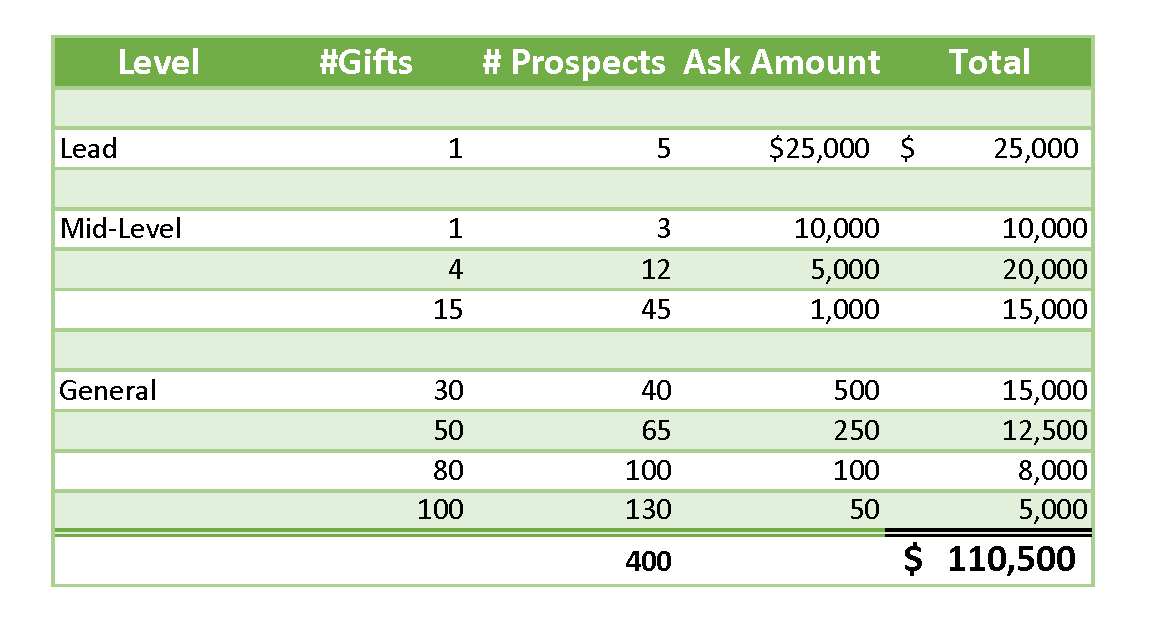
11 Jul Do You Have Enough Prospects? – A Fresh Take on Gift Charts
Or – How will we ever raise $100,000 this year?!?
If you can make a goal tangible, it will help you imagine it being real, and if you can make it real, you can make it possible.
(And frankly, if it’s not possible, you’re better off finding that out early, right?)
A gift chart can help. Here’s how.
Most of us are familiar with the basics of a gift chart – a list of gifts needed to make a specific goal with higher-level gifts listed first and smaller gifts listed below in descending tiers, sometimes called a donor pyramid.
Gift charts are commonly used in capital campaigns – and rarely used outside of campaigns.
But you can also use them for annual fundraising. Here’s how you might want to go about constructing one from scratch.
Prepare a theoretical gift chart first.
- Create a “lead gifts” category that adds to about 25% of the goal. That might be one person; it might be three or four. Add sub-levels as needed.
- Create a “mid-level” group of about 30 people who collectively represent 40% of the goal. Add sub-levels as needed.
- And create a “general gifts” group of everyone else who collectively add to 35%.
You’ll find a sample gift chart using the $100,000 example toward the bottom of this post.
Next assign the number of prospects needed for each level and/or sublevel.
- For the topmost lead gift(s), you’ll need five prospects for each gift.
- For every mid-level gift, you’ll need a ratio of 3:1.
- You won’t need as many prospects for the general gifts because some of the prospects for the larger gifts will be filling in the general gifts also – perhaps 1.3:1.
Now assign known donors to each of the prospect lines for the lead and mid-level gifts. This is the point at which it stops being theoretical and starts becoming real. The prospects may be individuals, businesses, or foundations, but there should be a specific person envisioned for each ask. Who will be making these gifts? Do you have enough prospects? If you need to adjust the pyramid up or down to make it fit your organization, that’s OK as long as you keep the ratios intact.
Last, start at the top and start asking – in person if possible, by phone or letter if not.
* * * * *
There are several advantages of thinking and planning like this:
- First, it forces us to think and plan in terms of asking the largest prospects first.
- It also forces us to think and plan to ask for specific amounts of money, instead of “please be generous.”
- If the top gifts do not come in as expected, and it therefore looks like we won’t make those revenue goals, it gives us the opportunity to adjust the budget before all the expenses have been committed.
And here’s a few final tips:
- Aim high by at least 10%. (Just in case Murphy shows up.)
- Make ask judgements based on what they gave last year, not necessarily what “everyone knows they could give.” This generally means not asking for more than four times their last year’s gift.
- Make all the asks for each level even if the first one is successful. (If you were looking for one gift at $10,000 would it really kill you to have three?)
- After the asks have all been made for each level, adjust the pyramid accordingly.
Cheers,
-da
Photo by Jeffrey Betts courtesy of Stocksnap.io.




Sorry, the comment form is closed at this time.